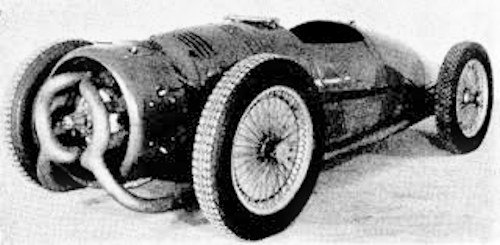Monaco Trossi 1935 Grand Prix car

The Monaco Trossi was an Italian race car from 1935, which should start in the Grand Prix European Championship.
History
Engineer Augusto Monaco, with the support of Fiat founder Giovanni Agnelli, designed a monoposto for the 750 kg class. After Fiat ended the collaboration, Monaco could win the wealthy racing driver and Count Carlo Felice Trossi as a partner. This car was of a very unusual design for its time. Constructed at Count Trossi's castle workshops at Biella in Northern Italy, the chassis frame was made of small-diameter tubing constructed along aircraft lines, a type of design which is now very common.
The engine, mounted on the nose, operated on the split-single principle, air-cooled, and the front wheels were driven by the superchargers. It was a new concept in racing but, because the pace of development in GP racing was so rapid at this time, this one-off special had little chance to succeed, and was never raced. The air cooled two stroke radial engine with 16 cylinders in two rows was located in front of the front axle and drove the front wheels. Thus, a good cooling of the engine was guaranteed, a drive shaft to the rear wheels could be omitted and a good traction of the front wheels was given by the front-heavy weight distribution. The eight pairs of cylinders were arranged in a star shape around the three-part crankshaft. In each of the two rows, eight pistons each acted on a main connecting rod and seven auxiliary connecting rods. Each cylinder pair had a cylinder head, which formed the common combustion chamber with only one spark plug for two pistons. The rear row of cylinders was charged by two Zoller compressors M 160, each with a Zenith carburettor. Two exhaust manifolds in front of the engine led the exhaust gases to two long exhaust pipes laterally under the body to the rear axle.
Directly behind the engine was the manual four-speed gearbox with differential arranged to drive the drive shafts to the front wheels. The clutch was located behind the transmission to the driver.
Manganese-molybdenum steel tubes from the aircraft industry with four centimetres in diameter formed the frame to which the light metal body parts were bolted. Double wishbones with horizontal coil springs led the wheels; The oil shock absorbers could be adjusted from the cockpit. The driven front wheels were significantly larger with 5.25 × 31 tires than the 4.40 × 27 rear wheels. The brake system consisted of four hydraulically operated drum brakes.
After the death of Carlo Felice Trossi in 1949, his widow, the Contessa Lisetta, donated the monoposto to the Museo dell ‘Automobile in Turin.
Technical
-
Monaco Trossi Technical details and specifications (1935)
Chassis:
tubular spaceframe.
Independent front suspension with lever-operated horizontal coil.
Independent rear suspension with lever-operated horizontal coilDimensions:
wheelbase 228cm (90in)Engine:
Capacity: 3,982cc
Bore and Stroke: 65 x 75mm
Monaco-Aymini, eight radial cylinders,
double piston, two-stroke
Zoller Type M160 superchargersGears:
four-speedMaximum Speed:
241 km/h (150mph)© Motor car History
